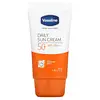Vaseline Daily Sun Cream SPF 50+ PA+++ Versus Mary & May Vegan Peptide Bakuchiol Sun Stick SPF 50+ PA++++
What's inside
What's inside
 Key Ingredients
Key Ingredients

 Benefits
Benefits

 Concerns
Concerns

 Ingredients Side-by-side
Ingredients Side-by-side

Water
Skin ConditioningGlycerin
HumectantEthylhexyl Methoxycinnamate
UV AbsorberTitanium Dioxide
Cosmetic ColorantCetearyl Ethylhexanoate
EmollientCyclopentasiloxane
Emollient4-Methylbenzylidene Camphor
UV AbsorberButyl Methoxydibenzoylmethane
UV AbsorberEthylhexyl Salicylate
UV AbsorberOctocrylene
UV AbsorberCyclohexasiloxane
EmollientPoly C10-30 Alkyl Acrylate
Emulsion StabilisingSilica
AbrasiveCetearyl Alcohol
EmollientGlyceryl Stearate
EmollientSorbitan Sesquioleate
EmulsifyingPEG-100 Stearate
Triceteareth-4 Phosphate
EmulsifyingPolysorbate 80
EmulsifyingPEG-2 Stearate
EmulsifyingGlycol Stearate
EmollientTromethamine
BufferingHomosalate
Skin ConditioningBenzotriazolyl Dodecyl P-Cresol
UV AbsorberPetrolatum 0.4%
EmollientCarbomer
Emulsion StabilisingHydroxyacetophenone
AntioxidantPotassium Cetyl Phosphate
EmulsifyingSodium Stearoyl Glutamate
CleansingPhenylbenzimidazole Sulfonic Acid
UV AbsorberParfum
MaskingDimethicone
EmollientEthylhexylglycerin
Skin ConditioningLinalool
PerfumingDisodium EDTA
Hexyl Cinnamal
PerfumingBenzyl Alcohol
PerfumingWater, Glycerin, Ethylhexyl Methoxycinnamate, Titanium Dioxide, Cetearyl Ethylhexanoate, Cyclopentasiloxane, 4-Methylbenzylidene Camphor, Butyl Methoxydibenzoylmethane, Ethylhexyl Salicylate, Octocrylene, Cyclohexasiloxane, Poly C10-30 Alkyl Acrylate, Silica, Cetearyl Alcohol, Glyceryl Stearate, Sorbitan Sesquioleate, PEG-100 Stearate, Triceteareth-4 Phosphate, Polysorbate 80, PEG-2 Stearate, Glycol Stearate, Tromethamine, Homosalate, Benzotriazolyl Dodecyl P-Cresol, Petrolatum 0.4%, Carbomer, Hydroxyacetophenone, Potassium Cetyl Phosphate, Sodium Stearoyl Glutamate, Phenylbenzimidazole Sulfonic Acid, Parfum, Dimethicone, Ethylhexylglycerin, Linalool, Disodium EDTA, Hexyl Cinnamal, Benzyl Alcohol
Cetyl Ethylhexanoate
EmollientMethyl Methacrylate Crosspolymer
Butylene Glycol Dicaprylate/Dicaprate
EmollientSynthetic Wax
AbrasiveVinyl Dimethicone/Methicone Silsesquioxane Crosspolymer
Isopropyl Palmitate
EmollientDicaprylyl Carbonate
EmollientButyloctyl Salicylate
Skin ConditioningDiethylamino Hydroxybenzoyl Hexyl Benzoate
UV FilterEthylhexyl Triazone
UV AbsorberOzokerite
Emulsion StabilisingPolysilicone-15
UV FilterBis-Ethylhexyloxyphenol Methoxyphenyl Triazine
Skin ConditioningBakuchiol
AntimicrobialVinyldimethicone
Titanium Dioxide
Cosmetic ColorantGlyceryl Caprylate
EmollientCaprylyl Glycol
EmollientPolyglyceryl-4 Diisostearate/Polyhydroxystearate/Sebacate
EmulsifyingCoco-Caprylate/Caprate
EmollientEthylhexylglycerin
Skin ConditioningPolyhydroxystearic Acid
EmulsifyingTriethoxycaprylylsilane
Aluminum Hydroxide
EmollientTocopherol
AntioxidantButylene Glycol
HumectantWater
Skin Conditioning1,2-Hexanediol
Skin ConditioningPolyglyceryl-10 Laurate
Skin ConditioningAcetyl Hexapeptide-8
HumectantAcetyl Octapeptide-3
HumectantNonapeptide-1
Skin ConditioningDipeptide-2
Skin ConditioningDipeptide-4
Skin ConditioningAcetyl Tetrapeptide-2
Skin ConditioningAcetyl Tetrapeptide-3
Skin ProtectingAcetyl Tetrapeptide-5
HumectantAcetyl Tripeptide-1
Skin ConditioningAlanine/Histidine/Lysine Polypeptide Copper Hcl
Skin ConditioningOligopeptide-6
Skin ConditioningCopper Tripeptide-1
Skin ConditioningTripeptide-1
Skin ConditioningTripeptide-2
Skin ConditioningTripeptide-3
Skin ConditioningPentapeptide-3
Skin ConditioningHexapeptide-2
BleachingHexapeptide-9
Skin ConditioningDipeptide Diaminobutyroyl Benzylamide Diacetate
Skin ConditioningPalmitoyl Dipeptide-7
Skin ConditioningPalmitoyl Tetrapeptide-7
Skin ConditioningPalmitoyl Tripeptide-1
Skin ConditioningPalmitoyl Tripeptide-5
Skin ConditioningPalmitoyl Pentapeptide-4
Skin ConditioningPalmitoyl Hexapeptide-12
Skin ConditioningAroma
Ultramarines
Cetyl Ethylhexanoate, Methyl Methacrylate Crosspolymer, Butylene Glycol Dicaprylate/Dicaprate, Synthetic Wax, Vinyl Dimethicone/Methicone Silsesquioxane Crosspolymer, Isopropyl Palmitate, Dicaprylyl Carbonate, Butyloctyl Salicylate, Diethylamino Hydroxybenzoyl Hexyl Benzoate, Ethylhexyl Triazone, Ozokerite, Polysilicone-15, Bis-Ethylhexyloxyphenol Methoxyphenyl Triazine, Bakuchiol, Vinyldimethicone, Titanium Dioxide, Glyceryl Caprylate, Caprylyl Glycol, Polyglyceryl-4 Diisostearate/Polyhydroxystearate/Sebacate, Coco-Caprylate/Caprate, Ethylhexylglycerin, Polyhydroxystearic Acid, Triethoxycaprylylsilane, Aluminum Hydroxide, Tocopherol, Butylene Glycol, Water, 1,2-Hexanediol, Polyglyceryl-10 Laurate, Acetyl Hexapeptide-8, Acetyl Octapeptide-3, Nonapeptide-1, Dipeptide-2, Dipeptide-4, Acetyl Tetrapeptide-2, Acetyl Tetrapeptide-3, Acetyl Tetrapeptide-5, Acetyl Tripeptide-1, Alanine/Histidine/Lysine Polypeptide Copper Hcl, Oligopeptide-6, Copper Tripeptide-1, Tripeptide-1, Tripeptide-2, Tripeptide-3, Pentapeptide-3, Hexapeptide-2, Hexapeptide-9, Dipeptide Diaminobutyroyl Benzylamide Diacetate, Palmitoyl Dipeptide-7, Palmitoyl Tetrapeptide-7, Palmitoyl Tripeptide-1, Palmitoyl Tripeptide-5, Palmitoyl Pentapeptide-4, Palmitoyl Hexapeptide-12, Aroma, Ultramarines
 Reviews
Reviews

Ingredients Explained
These ingredients are found in both products.
Ingredients higher up in an ingredient list are typically present in a larger amount.
Ethylhexylglycerin (we can't pronounce this either) is commonly used as a preservative and skin softener. It is derived from glyceryl.
You might see Ethylhexylglycerin often paired with other preservatives such as phenoxyethanol. Ethylhexylglycerin has been found to increase the effectiveness of these other preservatives.
Titanium dioxide is a mineral UV filter widely used in sunscreens and cosmetics.
It is one of only two UV filters officially classified as “mineral” by regulatory agencies, the other being zinc oxide.
Titanium dioxide provides broad-spectrum protection mostly in the UVB and UVAII range, with some protection in the UVAI range.
While its UVA protection isn’t as strong as zinc oxide’s, the difference is minor.
A common myth is that mineral UV filters reflect UV light. However, modern research shows titanium dioxide absorbs UV radiation like chemical filters (~95% absorption & 5% reflection).
Thanks to its non-irritating nature, titanium dioxide is suitable for sensitive, acne-prone, or redness-prone skin. It is unlikely to cause "eye sting" like other sunscreen ingredients.
A major drawback of this ingredient is its white cast and thick texture. This is why mineral sunscreens often leave a white cast and are less cosmetically elegant than chemical/hybrid sunscreens.
To improve white cast and spreadability, micronized or nano-sized titanium dioxide is often used.
There are ongoing concerns surrounding nano-titanium oxide's impact on marine ecosystems.
There is no conclusive evidence that any form of titanium oxide (or any other sunscreen ingredients) will cause harm to marine ecosystems or coral reefs. The science is still developing but many consumers are keeping a close eye on this issue.
Please note, many destinations have reef-safety sunscreen rules. For instance, the U.S. Virgin Islands advises all visitors to use non-nano mineral sunscreens.
Nano mineral sunscreens once raised safety concerns about absorption into skin.
Extensive research has shown that they do not penetrate healthy or damaged skin; they remain safely on the surface and the top layer of dead skin (stratum corneum).
You'll likely find titanium dioxide bundled with alumina, silica, or dimethicone. These ingredients help make titanium dioxide highly photostable; this prevents it from interacting with other formula components under UV light.
Learn more about Titanium DioxideWater. It's the most common cosmetic ingredient of all. You'll usually see it at the top of ingredient lists, meaning that it makes up the largest part of the product.
So why is it so popular? Water most often acts as a solvent - this means that it helps dissolve other ingredients into the formulation.
You'll also recognize water as that liquid we all need to stay alive. If you see this, drink a glass of water. Stay hydrated!
Learn more about Water